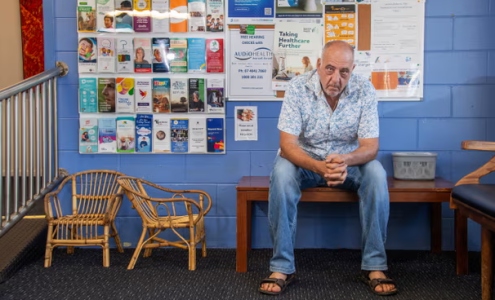If you’ve ever worried about getting older in the bush…this will hit home
By
Maan
- Replies 17
Accessing quality aged care is something every Australian should be able to count on—no matter where they live.
But for families in regional towns, the reality can be far more complicated, especially when distance, language and limited services come into play.
This story highlights the growing strain on rural communities as they struggle to support their ageing loved ones with little outside help.
In the final years of her life, Angiolina Moro stopped speaking English altogether.
Her son, Joe Moro, explained: ‘She was in her late 20s when she arrived in Australia. So as her dementia creeped in, she lost the capacity to speak in English.’
Angiolina passed away in February after five years in an aged care facility in Mount Kooyong, 50km north of Mareeba—the far north Queensland town where she had spent most of her adult life.
For Joe, the distance from Mareeba was more than just a logistical issue—it created a language barrier that lingered until the end. Around 10 per cent of Mareeba’s population was Italian, and his mother would have felt more at home there. ‘I know the staff [at Mount Kooyong] spent a lot of effort trying to communicate,’ he said. ‘I think they did a fantastic job.’
He acknowledged the broader challenge affecting many in the area: ‘A lot of older people in the [region] are the first lot of immigrants who came back in the 50s and worked hard and are now deteriorating and ending up in homes. So language is a big barrier up here for getting good outcomes in care.’
Mareeba’s isolation didn’t help. Many locals were left with few aged care options. Some elderly residents relocated to Cairns, about 60 km away, to stay closer to their children’s workplaces. Yet for most, the desire to remain in their smaller communities was deeply rooted.
Ross Cardillo had seen this firsthand. He sold his business years ago to help on the family lychee and longan farm and support his 77-year-old mother as she cared for his 83-year-old father at home.
‘There’s just not sufficient care in Mareeba,’ he said. ‘[Dad] wants to stay home, which is fair enough. If he goes to an aged care facility, he will die. And my mother won’t let him die.’
That sentiment echoed throughout rural Australia. The farther people lived from metropolitan centres, the less access they had to reliable in-home aged care. Cardillo knew plenty who travelled an hour or more for services—and that distance only grew in more remote areas.
As chair of Mareeba and Communities Family Healthcare, Cardillo had taken a proactive stance. The not-for-profit was created five years ago to improve healthcare locally and, more recently, expanded its reach. In May, it opened an outreach clinic in Mutchilba, 35 km south-west of Mareeba, to assist the 600 residents—many of them elderly—so they didn’t have to travel as far.
‘We are trying to cater for our ageing population with little or no support from anyone else,’ he said. ‘As a community, we see it as valuable and important and we’re pursuing that. It’s about opening up funding to more providers that are available up here.’
Joe Moro, also president of the Mareeba Chamber of Commerce, supported the initiative but believed more resources were needed to do the job properly. ‘We have an overall shortage here,’ he said. ‘There are numerous councils trying to get investment and there’s talk of something going to happen—at the end of the day it’s an investment issue.’
A 2023 report from the National Rural Health Alliance estimated rural Australians missed out on $850 worth of healthcare annually due to lack of local services. That translated to a staggering $6.5 billion underspend across rural areas.
Alliance chief executive, Susi Tegen, said many communities had taken matters into their own hands. Some even fundraised for aged care themselves.
She labelled the lack of government support ‘geographic narcissism’.
‘Some communities are coming up with models that are much better and allow for support from the local community,’ she said. ‘However, they are often not funded. They rely on volunteers and they are often not considered by government funding to be good enough. And yet, we seem to see a population that is being told by the lack of funding that they’re not as important as urban people.’
In New South Wales, the Snowy Mountains town of Bombala took drastic measures to save their aged care home, producing a nude calendar to raise money after the facility shut down due to staff shortages in 2022.
Tegen believed both state and federal governments needed to act now to meet the needs of a rapidly ageing population. According to the Australian Bureau of Statistics, Australians aged over 65 were expected to almost double from 3.8 million in 2017 to 6.4 million by 2042.
Yet attracting healthcare workers to regional areas remained a major hurdle. ‘They’re having to beg and scrape, and they’re having to jump through hoops to get the money that everyone else seems to be getting in the city,’ Tegen said.
In March, the federal government announced a $600 million boost for in-home care services in regional Australia and for people from diverse backgrounds. Nearly $1 billion was also allocated to the Aged Care Capital Assistance Program to improve or expand aged care facilities and accommodation in underserviced areas.
Still, for communities like Mareeba, those dollars felt far away.
Cardillo remained unconvinced the funding would ever reach them. ‘They get things done themselves and they do it themselves,’ he said.

With so many rural Aussies left to fill the gaps in aged care themselves, do you think the system is truly looking after our older generations? Let us know your thoughts in the comments.
In a previous story, we took a closer look at the difficult trade-offs older Australians face as aged care funding reforms continue to shake the system.
For seniors in regional towns already struggling with limited access and support, the question of what gets prioritised—dignity or basic needs—feels all too familiar.
If that reality sounds close to home, this one’s worth a read too.
Read more: Dignity or Dinner? The High Stakes of Australia’s Aged Care Funding Reforms
But for families in regional towns, the reality can be far more complicated, especially when distance, language and limited services come into play.
This story highlights the growing strain on rural communities as they struggle to support their ageing loved ones with little outside help.
In the final years of her life, Angiolina Moro stopped speaking English altogether.
Her son, Joe Moro, explained: ‘She was in her late 20s when she arrived in Australia. So as her dementia creeped in, she lost the capacity to speak in English.’
Angiolina passed away in February after five years in an aged care facility in Mount Kooyong, 50km north of Mareeba—the far north Queensland town where she had spent most of her adult life.
For Joe, the distance from Mareeba was more than just a logistical issue—it created a language barrier that lingered until the end. Around 10 per cent of Mareeba’s population was Italian, and his mother would have felt more at home there. ‘I know the staff [at Mount Kooyong] spent a lot of effort trying to communicate,’ he said. ‘I think they did a fantastic job.’
He acknowledged the broader challenge affecting many in the area: ‘A lot of older people in the [region] are the first lot of immigrants who came back in the 50s and worked hard and are now deteriorating and ending up in homes. So language is a big barrier up here for getting good outcomes in care.’
Mareeba’s isolation didn’t help. Many locals were left with few aged care options. Some elderly residents relocated to Cairns, about 60 km away, to stay closer to their children’s workplaces. Yet for most, the desire to remain in their smaller communities was deeply rooted.
Ross Cardillo had seen this firsthand. He sold his business years ago to help on the family lychee and longan farm and support his 77-year-old mother as she cared for his 83-year-old father at home.
‘There’s just not sufficient care in Mareeba,’ he said. ‘[Dad] wants to stay home, which is fair enough. If he goes to an aged care facility, he will die. And my mother won’t let him die.’
That sentiment echoed throughout rural Australia. The farther people lived from metropolitan centres, the less access they had to reliable in-home aged care. Cardillo knew plenty who travelled an hour or more for services—and that distance only grew in more remote areas.
As chair of Mareeba and Communities Family Healthcare, Cardillo had taken a proactive stance. The not-for-profit was created five years ago to improve healthcare locally and, more recently, expanded its reach. In May, it opened an outreach clinic in Mutchilba, 35 km south-west of Mareeba, to assist the 600 residents—many of them elderly—so they didn’t have to travel as far.
‘We are trying to cater for our ageing population with little or no support from anyone else,’ he said. ‘As a community, we see it as valuable and important and we’re pursuing that. It’s about opening up funding to more providers that are available up here.’
Joe Moro, also president of the Mareeba Chamber of Commerce, supported the initiative but believed more resources were needed to do the job properly. ‘We have an overall shortage here,’ he said. ‘There are numerous councils trying to get investment and there’s talk of something going to happen—at the end of the day it’s an investment issue.’
A 2023 report from the National Rural Health Alliance estimated rural Australians missed out on $850 worth of healthcare annually due to lack of local services. That translated to a staggering $6.5 billion underspend across rural areas.
Alliance chief executive, Susi Tegen, said many communities had taken matters into their own hands. Some even fundraised for aged care themselves.
She labelled the lack of government support ‘geographic narcissism’.
‘Some communities are coming up with models that are much better and allow for support from the local community,’ she said. ‘However, they are often not funded. They rely on volunteers and they are often not considered by government funding to be good enough. And yet, we seem to see a population that is being told by the lack of funding that they’re not as important as urban people.’
In New South Wales, the Snowy Mountains town of Bombala took drastic measures to save their aged care home, producing a nude calendar to raise money after the facility shut down due to staff shortages in 2022.
Tegen believed both state and federal governments needed to act now to meet the needs of a rapidly ageing population. According to the Australian Bureau of Statistics, Australians aged over 65 were expected to almost double from 3.8 million in 2017 to 6.4 million by 2042.
Yet attracting healthcare workers to regional areas remained a major hurdle. ‘They’re having to beg and scrape, and they’re having to jump through hoops to get the money that everyone else seems to be getting in the city,’ Tegen said.
In March, the federal government announced a $600 million boost for in-home care services in regional Australia and for people from diverse backgrounds. Nearly $1 billion was also allocated to the Aged Care Capital Assistance Program to improve or expand aged care facilities and accommodation in underserviced areas.
Still, for communities like Mareeba, those dollars felt far away.
Cardillo remained unconvinced the funding would ever reach them. ‘They get things done themselves and they do it themselves,’ he said.
Key Takeaways
- Language and distance made aged care especially difficult for immigrants like Angiolina Moro in rural areas.
- Locals such as Ross Cardillo supported elderly family at home due to a lack of aged care options nearby.
- Community groups opened outreach clinics with little external help while urging more government investment.
- Despite government funding pledges, experts said rural Australians still faced major gaps in aged care access.
With so many rural Aussies left to fill the gaps in aged care themselves, do you think the system is truly looking after our older generations? Let us know your thoughts in the comments.
In a previous story, we took a closer look at the difficult trade-offs older Australians face as aged care funding reforms continue to shake the system.
For seniors in regional towns already struggling with limited access and support, the question of what gets prioritised—dignity or basic needs—feels all too familiar.
If that reality sounds close to home, this one’s worth a read too.
Read more: Dignity or Dinner? The High Stakes of Australia’s Aged Care Funding Reforms
Last edited:








